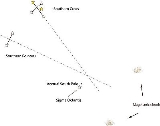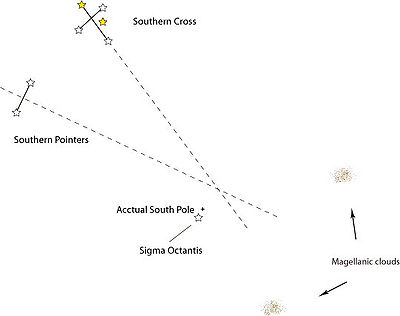
Polar Alignment
Encyclopedia
Polar alignment is the act of aligning the rotational axis
of a telescope
's equatorial mount
in parallel with that of the Earth. There are various ways to achieve this.
or Southern Hemisphere
and σ. The purpose of the alignment also must be considered. For example, the demand for accuracy is much more significant in astrophotography
than in occasional stargazing.
the North Star is the usual procedure for aligning a telescope mount parallel to the Earth's axis.
the South Star

The procedure for the Northern Hemisphere is as follows:
Step 1 Point the telescope at a star due South that is close to declination 0 degrees.
Step 2 Rotate the guider CCD or reticule eyepiece in the telescope so that moving the mount in Right Ascension causes the star to follow a crosshair line very accurately. Consider this line to be the ‘horizontal’. If the mount’s tracking is switched off for a few minutes the star should follow this line.
Step 3 Position the star exactly on the centre of the cross hairs.
Step 4 Leave the mount tracking and note the drift direction of the star away from the crosshair centre.
Step 5 While watching the position of the star, put a hand on the scope and push gently either up or down - enough to move the star visibly.
Figure out if you need to push UP to re-centre the star or DOWN.
Step 6 If you need to push UP, use the azimuth adjustment to rotate the whole mount clockwise (imagine looking at the mount from above).
If you had to push DOWN, rotate the mount anti-clockwise.
Start with a small rotation to get a sense of how much change the rotation will produce.
Step 7 Go back to step 4. Keep repeating steps 4 to 7 until the star does not drift up or down for at least 5 minutes.
(Remember, sideways drift is not important).
Step 8 Now point the scope at a star low in the West.
Step 9 Centre the star perfectly and let the mount track until a drift is observed.
Step 10 Put a hand on the scope and give a gentle push. If you have to push the scope UP to re-centre the star, then you must increase the angle that the polar axis makes with the horizontal. If you need to push DOWN then the angle must be reduced.
(It is probably wise to figure out which way the adjustment knobs move your mount in daylight before you do the actual drift alignment. It is quite easy to get confused in the dark and go the wrong way.)
You should then repeat the whole procedure until no drift is seen for 10-20 minutes.
eyepiece
is an ordinary ocular with the only difference that it has a crosshair for aiming and measurement of the angular distance
. This is useful in any type of polar alignment, but especially in drift.
Rotation around a fixed axis
Rotation around a fixed axis is a special case of rotational motion. The fixed axis hypothesis exclude the possibility of a moving axis, and cannot describe such phenomena as wobbling or precession. According to Euler's rotation theorem, simultaneous rotation around more than one axis at the same...
of a telescope
Telescope
A telescope is an instrument that aids in the observation of remote objects by collecting electromagnetic radiation . The first known practical telescopes were invented in the Netherlands at the beginning of the 1600s , using glass lenses...
's equatorial mount
Equatorial mount
An equatorial mount is a mount for instruments that follows the rotation of the sky by having one rotational axis parallel to the Earth's axis of rotation. This type of mount is used for astronomical telescopes and cameras...
in parallel with that of the Earth. There are various ways to achieve this.
Alignment Methods
The method to use differs depending on if the alignment is taking place in daylight or in night. Furthermore, the method differs if the alignment is done in the Northern HemisphereNorthern Hemisphere
The Northern Hemisphere is the half of a planet that is north of its equator—the word hemisphere literally means “half sphere”. It is also that half of the celestial sphere north of the celestial equator...
or Southern Hemisphere
Southern Hemisphere
The Southern Hemisphere is the part of Earth that lies south of the equator. The word hemisphere literally means 'half ball' or "half sphere"...
and σ. The purpose of the alignment also must be considered. For example, the demand for accuracy is much more significant in astrophotography
Astrophotography
Astrophotography is a specialized type of photography that entails recording images of astronomical objects and large areas of the night sky. The first photographs of an astronomical object were taken in the 1840s, but it was not until the late 19th century that advances in technology allowed for...
than in occasional stargazing.
Northern Hemisphere
Sighting on PolarisPolaris
Polaris |Alpha]] Ursae Minoris, commonly North Star or Pole Star, also Lodestar) is the brightest star in the constellation Ursa Minor. It is very close to the north celestial pole, making it the current northern pole star....
the North Star is the usual procedure for aligning a telescope mount parallel to the Earth's axis.
Southern Hemisphere
σ OctantisSigma Octantis
Sigma Octantis is a magnitude 5.6 star in the constellation Octans most notable for being the current South Star. Sigma Octantis is approximately 270 light years from Earth, and is classified as a giant, with a spectral type of F0 III...
the South Star

Drift Alignment
A rough alignment is performed - then refined by pointing at different stars and observing any drift that occurs. The mount is then adjusted according to the direction of the observed drift.The procedure for the Northern Hemisphere is as follows:
Step 1 Point the telescope at a star due South that is close to declination 0 degrees.
Step 2 Rotate the guider CCD or reticule eyepiece in the telescope so that moving the mount in Right Ascension causes the star to follow a crosshair line very accurately. Consider this line to be the ‘horizontal’. If the mount’s tracking is switched off for a few minutes the star should follow this line.
Step 3 Position the star exactly on the centre of the cross hairs.
Step 4 Leave the mount tracking and note the drift direction of the star away from the crosshair centre.
Step 5 While watching the position of the star, put a hand on the scope and push gently either up or down - enough to move the star visibly.
Figure out if you need to push UP to re-centre the star or DOWN.
Step 6 If you need to push UP, use the azimuth adjustment to rotate the whole mount clockwise (imagine looking at the mount from above).
If you had to push DOWN, rotate the mount anti-clockwise.
Start with a small rotation to get a sense of how much change the rotation will produce.
Step 7 Go back to step 4. Keep repeating steps 4 to 7 until the star does not drift up or down for at least 5 minutes.
(Remember, sideways drift is not important).
Step 8 Now point the scope at a star low in the West.
Step 9 Centre the star perfectly and let the mount track until a drift is observed.
Step 10 Put a hand on the scope and give a gentle push. If you have to push the scope UP to re-centre the star, then you must increase the angle that the polar axis makes with the horizontal. If you need to push DOWN then the angle must be reduced.
(It is probably wise to figure out which way the adjustment knobs move your mount in daylight before you do the actual drift alignment. It is quite easy to get confused in the dark and go the wrong way.)
You should then repeat the whole procedure until no drift is seen for 10-20 minutes.
Crosshair Eyepiece
A crosshairCrosshair
A reticle is a net of fine lines or fibers in the eyepiece of a sighting device, such as a telescope, a telescopic sight, a microscope, or the screen of an oscilloscope. The word reticle comes from the Latin "reticulum," meaning "net." Today, engraved lines or embedded fibers may be replaced by a...
eyepiece
Eyepiece
An eyepiece, or ocular lens, is a type of lens that is attached to a variety of optical devices such as telescopes and microscopes. It is so named because it is usually the lens that is closest to the eye when someone looks through the device. The objective lens or mirror collects light and brings...
is an ordinary ocular with the only difference that it has a crosshair for aiming and measurement of the angular distance
Angular distance
In mathematics and all natural sciences , the angular distance between two point objects, as observed from a location different from either of these objects, is the size of the angle between the two directions originating from...
. This is useful in any type of polar alignment, but especially in drift.

